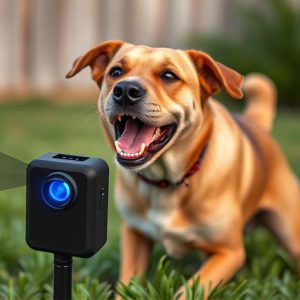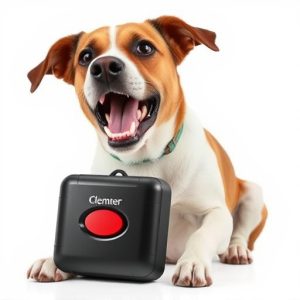Handheld Dog Deterrents: Training Tools with Ethical Considerations
Sound wave technology offers a humane alternative to traditional pet training with handheld dog dete…….
Sound wave technology offers a humane alternative to traditional pet training with handheld dog deterrents. These devices emit inaudible, high-frequency sounds to disrupt dogs' behavior without harm, available in various types and carrying methods for convenience. Safe and effective use requires proper technique, understanding device settings, and prioritizing positive reinforcement training. Responsible owners should consider these tools as a last resort after exploring other methods, using them ethically with patience and trust-building exercises. Handheld dog deterrent carrying methods play a crucial role in ensuring safe, controlled behavior modification.
Sound wave pet behavior control has emerged as a revolutionary tool in animal training, offering non-invasive solutions for modifying behavior. This article explores the capabilities of sound wave technology for pet behavior modification, focusing on handheld dog deterrent devices. We’ll delve into different types, safe carrying methods, and ethical considerations. Additionally, discover effective training tips leveraging positive reinforcement to ensure successful and responsible implementation. Key terms: Handheld Dog Deterrent Carrying Methods.
- Understanding Sound Wave Technology for Pet Behavior Modification
- Handheld Dog Deterrent Devices: Types and Functionality
- Effective Carrying Methods for Safe and Efficient Use
- Ethical Considerations and Training Tips for Positive Reinforcement
Understanding Sound Wave Technology for Pet Behavior Modification
Sound wave technology has emerged as a unique and innovative approach to modifying pet behavior, offering an alternative to traditional training methods. This technology utilizes specific sound frequencies to influence an animal’s actions and reactions, making it a powerful tool for dog owners looking to address behavioral issues. By emitting sounds that are often inaudible to humans, these devices can capture a dog’s attention without causing harm or distress.
Handheld dog deterrents employing this technology have gained popularity due to their convenience and effectiveness. These portable devices allow pet owners to target specific behaviors like barking, jumping, or aggression by emitting high-frequency sounds that disrupt the animal’s focus. The method is non-invasive and can be used as a positive reinforcement tool when combined with other training techniques. With various carrying methods available, such as belts or lanyards, these devices offer pet owners a practical solution for managing their dog’s behavior during walks or in specific environments.
Handheld Dog Deterrent Devices: Types and Functionality
Handheld Dog Deterrent Devices, also known as ultrasonic pet trainers or sound wave emission tools, are popular for their non-violent approach to modifying pet behavior. These devices emit high-frequency sound waves that are inaudible to humans but irritating to dogs, prompting them to alter their actions. They come in various types, including handheld models, which offer both convenience and versatility.
The carrying methods for these devices range from simple, lightweight designs that fit comfortably in the palm of your hand to more robust options with additional features like adjustable frequency settings and longer battery life. Some models even include safety features to prevent accidental activation. These handheld devices are often used for training purposes, such as deterring barking or encouraging good behavior, making them a favorite among pet owners looking for effective yet humane solutions.
Effective Carrying Methods for Safe and Efficient Use
When it comes to handheld dog deterrent devices, proper carrying methods are essential for safe and effective use. The first step is to ensure comfort and control—choose a device that fits comfortably in your hand, allowing for easy maneuverability. This not only enhances your ability to direct sound waves accurately but also reduces strain during extended use. Many modern handheld deterrents offer ergonomic designs, featuring non-slip grips and lightweight materials, making them suitable for daily training sessions or emergency situations.
For safe operation, familiarize yourself with the device’s range and power settings. Different carrying methods can impact sound projection; standing upright allows for a broader beam width, ideal for controlling multiple dogs from a distance. Kneeling or sitting lowers the center of gravity, enabling more precise targeting of individual animals while minimizing the risk of unintended bystanders. Regular practice in various positions will help you master effective handheld dog deterrent carrying techniques, ensuring consistent and reliable performance during training or correction.
Ethical Considerations and Training Tips for Positive Reinforcement
When employing sound wave pet behavior control devices, such as handheld dog deterrents, it’s paramount to navigate ethical considerations carefully. These devices use ultrasonic sounds that are inaudible to humans but can prompt reactions from animals. While they’re often used for dogs, ensuring their humane application is crucial. For instance, avoiding direct contact or sudden activation near sensitive areas like eyes or ears can prevent potential distress. Additionally, using these tools only as a last resort after trying positive reinforcement training methods shows consideration for the animal’s well-being and emotional state.
Training tips for positive reinforcement play a significant role in effective behavior control. Incorporating treats and praise during training sessions strengthens the bond between pet and owner while teaching desired behaviors. Consistency is key; using the same commands and signals repeatedly helps pets understand expectations. Patience and positive reinforcement create an environment of trust, making sound wave deterrents more effective tools for addressing unwanted behaviors like barking or jumping. Moreover, employing handheld dog deterrent carrying methods that are comfortable and secure for both pet and owner facilitates safe and responsible use during training sessions.
Sound wave technology offers a innovative and humane approach to pet behavior control, with handheld dog deterrent devices as a versatile tool. By understanding the principles behind this technology, choosing the right device, and employing effective carrying methods, owners can safely and efficiently modify their pets’ behavior. Ethical considerations and positive reinforcement training tips further ensure a successful and positive outcome for both pets and their owners. When used responsibly, these methods can revolutionize pet training, fostering better relationships between humans and their furry companions.


